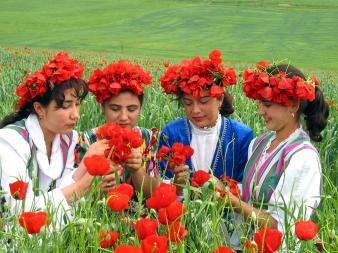EE00001356
 Nawrouz, Novruz, Nowrouz, Nowrouz, Nawrouz, Nauryz, Nooruz, Nowruz, Navruz, Nevruz, Nowruz, Navruz
Nawrouz, Novruz, Nowrouz, Nowrouz, Nawrouz, Nauryz, Nooruz, Nowruz, Navruz, Nevruz, Nowruz, Navruz
It is the New Year by solar calendar in Central, South and South-West Asia countries. According to sources, Navruz was one of the biggest festivities among Iranian and Turkic peoples. Mahmud al-Kashgari in his work called "Diwanu l-Lugat al-Turk" mentions about many folk songs, which were dedicated to Navruz. Also, the information about Navruz festivity can be found in such works as "The remaining traces of past centuries" (written by Abu Rayhan al-Biruni), "Navruzname" (by Omar Khayyam), and those written by Alisher Navoi, Zahir-ud-Din Muhammad Babur and other scholars.
In the territory of Central Asia Navruz festivity was associated with the beginning of the New Year. As such, the preparations for it began several days ahead. Wheat was germinated and from its sprouts sumalak was cooked, dumplings with greens and samosas with mint were prepared. Also folk games were organized (such as horseracing, uloq, kurash, etc.), promenades were arranged, songs about spring were sung, terma and dostons were performed (by bakhshis). On the first day of Navruz children, living in rural areas, gathered in groups and sang songs dedicated to Navruz before the doors of houses. And the owner of the house, hearing these songs, came out, gave presents to children, and treated them with food. In their turn, children distributed one part of the food among widows and orphans living in the village. All these traditions and customs are still alive.
Iran,India,Turkey,Pakistan,Afghanistan,Uzbekistan,Kazakhstan,Kyrgyzstan,Tajikistan,Turkmenistan,Iraq,Azerbaijan
2016


